The Reading Chair: Fall 2024
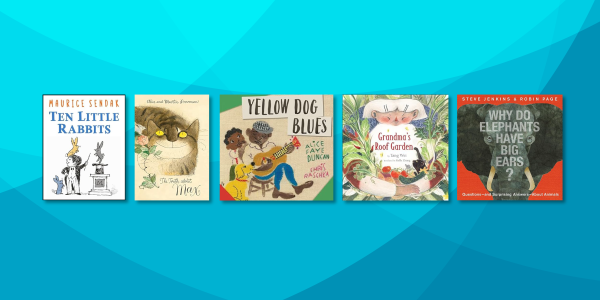
You are here
Learning about emotions—what they are and what to do with them—is part of a quality early childhood curriculum. As we selected books for this edition of The Reading Chair, we were struck by the honesty of many of the character portrayals and what children might learn from them, with scaffolding from a teacher. For example, in Ten Little Rabbits, Maurice Sendak draws a magician who is full of frustration and annoyance, delighted to banish 10 cute bunnies. In The Truth About Max, a self-absorbed and destructive cat is welcomed in the family just as he is. A beloved dog chooses to leave his family behind in Yellow Dog Blues, in contrast to reader expectations.
These characters give readers a chance to explore uncomfortable emotions within the context of a safe and supportive early learning space. This can validate uncomfortable feelings children experience as well as show how characters resolve those feelings. Learning about complex characters spurs empathy and helps children see that others’ actions are not all good or all bad, but rather a mix of both. Each of these characters is full of charm too, offering opportunities to talk about a range of emotions and what we can do with them.
—Isabel Baker and Miriam Baker Schiffer
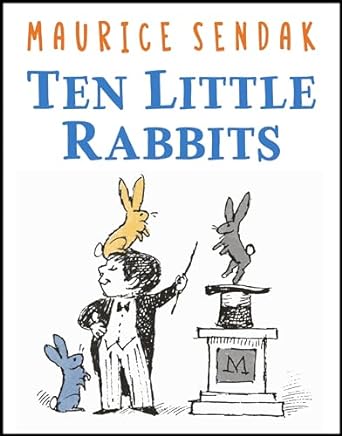 Ten Little Rabbits
Ten Little Rabbits
By Maurice Sendak. 2024 (1970).
New York: HarperCollins. 32 pp. Ages 1 to 5.
Originally published in a nonbook format in 1970, this delightful work by Maurice Sendak is now easily accessible as a picture book for the first time. It is a counting book that is so much more. Sendak’s illustrations use deceptively simple black-and-white lines, limited color, and lots of negative (or blank) space to thoroughly engage readers in a magic show. A magician pulls 10 rabbits out of a hat, counting them one at a time. As the act progresses, so do the magician’s frustrations, which children will love to comment on. It’s not easy having 10 rabbits underfoot! But then comes the resolution: he makes the rabbits disappear one at a time, giving children an opportunity to count down from 10 as well and giving the magician a chance to regain his composure.
Sendak’s facility with facial expressions and body language turns this simple plot into a complete and satisfying story. Teachers can encourage social and emotional awareness by asking children how they think the magician is feeling based on his changing expressions.
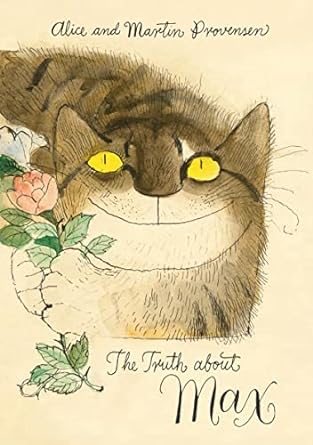 The Truth About Max
The Truth About Max
By Alice and Martin Provensen. 2023.
New York: Enchanted Lion Books. 40 pp. Ages 2 to 7.
Meet Max, a larger-than-life cat who is, endearingly, a handful. With expressive illustrations and to-the-point text, Max and those around him come alive. Max is into the sugar, tangled in yarn, tussling with the other pets, and collecting squirrel tails, if you catch the drift. He’s also bright and self-sufficient. Max is a mighty hunter, with sharp teeth, long whiskers, and an important tail that communicates how he is feeling. It’s wonderful to read about a cat who is mischievous and accepted for all of these qualities. Readers will love him and the acceptance he receives. They may also recognize and talk about the need for Max to venture out on his own at the end of the day.
Author Martin Provensen, of the award-winning husband-and-wife pair who created the book, said that Max was his alter ego, daring to do what Martin wouldn’t. This engaging profile of a farm cat has the unapologetic emotional straightforwardness of a classic.
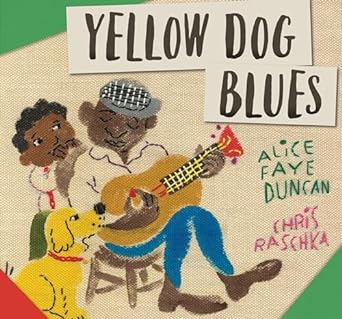 Yellow Dog Blues
Yellow Dog Blues
By Alice Faye Duncan. Illus. by Chris Raschka. 2022.
Grand Rapids, MI: Eerdmans Books for Young Readers. 32 pp. Ages 3 to 8.
When Bo Willie’s dog goes missing, readers follow along on the boy’s pavement-pounding search to locate his pup. Bo Willie’s dance-loving aunt drives him in her pink Cadillac from town to town through the Mississippi Delta, looking for Yellow Dog. But Duncan throws a twist when it turns out that Yellow Dog has left to sing the blues with a band on Beale Street in Memphis. Bo Willie has to come to terms with the realization that the dog has dreams of its own and wants the freedom to fulfill them.
Duncan’s language is a pleasure to read, infused with rhythm and movement and the sound of the blues. Two-time Caldecott winner Chris Raschka’s illustrations have his signature sway and are full of feeling. But this time Raschka introduces needlework and embroidery into his art to create dramatic highlights, lines, text, and definition. The result is original, unique, and appealing. The author’s website offers a free activity kit that includes a blues-writing worksheet fashioned like Mad Libs, blues history and resources, information and activities based on Rashka’s fabric- and embroidery-based art, discussion questions, and further reading.
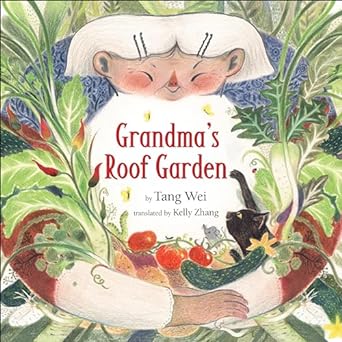 Grandma’s Roof Garden
Grandma’s Roof Garden
By Tang Wei. Translated by Kelly Zhang. 2024.
Hoboken, NJ: Levine Querido. 40. Ages 4 to 7.
Granny lives a vibrant life, maintaining a bustling garden—full of vegetable plants, hens, and geese—on the rooftop of her apartment building. She believes each plant and animal deserves great care. She visits the green market and picks from the free and damaged produce that the sellers leave behind so she can give her animals fresh food and support the compost pile that feeds her plants. Once harvest time arrives, Granny’s efforts really shine, and we see that she is not just a vital and energetic individual, but also a generous member of the community. She shares vegetables with all her neighbors and throws a party for her family. She cooks eggplants glazed with tangy sauce, cucumbers dressed with fragrant vinegar, tofu stewed with wood ear mushrooms, and more.
Wei was inspired by an elderly relative who was expected to slow down in retirement but stayed fit and well-fed this way instead. The story touches on themes of family, Chinese culture, valuing older adults, healthy living, environmental conservation, and gardening. Brightly colored pencil illustrations show the liveliness of each character—human, animal, and plant. Teachers can incorporate this book into units on gardening, composting, reusing, or cooking.
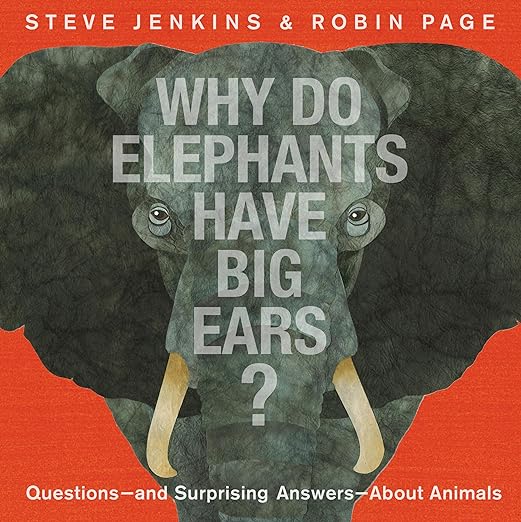 Why Do Elephants Have Big Ears? Questions—and Surprising Answers—About Animals
Why Do Elephants Have Big Ears? Questions—and Surprising Answers—About Animals
By Steve Jenkins and Robin Page. 2023.
New York: Little, Brown. 40 pp. Ages 4 to 9.
This is a gorgeous book full of interesting animal facts from husband-and-wife team Steve Jenkins and Robin Page. In their collage-style illustrations, one animal dramatically pops off each page or spread, mesmerizing the reader. Accompanying text presents unusual and fascinating information. Did you know that hippos swish their tails while pooping as a way of marking their territory? Camels store fat in their humps to provide sustenance during long stretches in the desert, and it’s kept on their backs rather than spread out so it doesn’t warm up their entire body in an already hot climate.
Each page includes a small drawing showing the animal’s size compared to a human. The pictures alone will capture a very young reader’s attention. Older readers will enjoy the detailed information about each animal as well as the extensive back matter, which goes into even more depth.
Copyright © 2024 by the National Association for the Education of Young Children. See Permissions and Reprints online at NAEYC.org/resources/permissions.
Isabel Baker, MAT, MLS, is the founding director of The Book Vine for Children, a national company dedicated to getting good books into the hands of preschool children and their teachers. Isabel has worked as a children’s librarian and is currently a presenter on early literacy and book selection.
Miriam Baker Schiffer, MFA, is a writer in Brooklyn, New York. She consults on book selections for The Book Vine, in McHenry, Illinois. Miriam’s children’s book, Stella Brings the Family, was published by Chronicle Books in 2015.